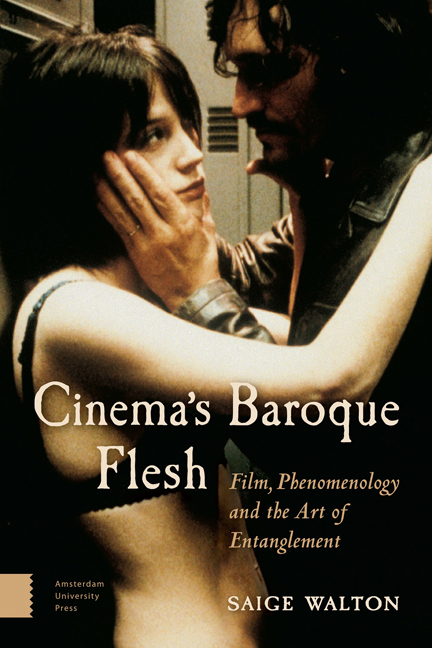Book contents
- Frontmatter
- Dedication
- Contents
- Acknowledgements
- Introduction
- 1 Flesh, Cinema and the Baroque: The Aesthetics of Reversibility
- 2 Knots of Sensation: Co-Extensive Space and a Cinema of the Passions
- 3 Baroque Skin/Semiotics
- 4 One Hand Films the Other: Baroque Haptics
- Conclusion: Or the Baroque ‘Beauty of the Act’
- Notes
- Bibliography
- Filmography
- Index
2 - Knots of Sensation: Co-Extensive Space and a Cinema of the Passions
Published online by Cambridge University Press: 12 February 2021
- Frontmatter
- Dedication
- Contents
- Acknowledgements
- Introduction
- 1 Flesh, Cinema and the Baroque: The Aesthetics of Reversibility
- 2 Knots of Sensation: Co-Extensive Space and a Cinema of the Passions
- 3 Baroque Skin/Semiotics
- 4 One Hand Films the Other: Baroque Haptics
- Conclusion: Or the Baroque ‘Beauty of the Act’
- Notes
- Bibliography
- Filmography
- Index
Summary
The baroque propitiates emotive participants, it empties them, it excites them, it tunes and sharpens the fleeting perceptions. Sensual, it accepts the immediate givens of consciousness, it likes voluptuous immersions, to be possessed and overflowed.
– Saúl Yurkiévich (‘Baroque Fusions’, p. 112)What makes the weight, the thickness, the flesh of each color, of each sound, of each tactile texture […] is the fact that he who grasps them feels himself emerge from them by a sort of coiling up or redoubling, fundamentally homogenous with them; he feels that he is the sensible itself coming to itself and that in return the sensible is in his eyes as it were his double or an extension of his own flesh.
– Maurice Merlaeu-Ponty (VI, pp. 113-114)This chapter fleshes out my vision of baroque flesh by examining how the baroque knots sensation together with a deliberate breaching of borders, frames, and surfaces. To adopt a neologism of Sobchack, in this chapter I will examine how baroque cinema is porous in its spatiality and ‘cinesthetic’ in its texturing of sensation (Carnal Thoughts, p. 67). Not only does this concept endow the film's body with a deeper and more luscious sensuality than has heretofore been described, it helps establish how cinema ‘uses our dominant senses of vision and hearing to speak comprehensibly to our senses’, and how we as viewers ‘do not only experience any movie through only our eyes’ (Sobchack, Carnal Thoughts, pp. 67, 63). A cinema of baroque flesh is not limited to sight and sound, although it is channelled and expressed through those senses.
For Sobchack, cinesthesia speaks to the doubled embodiment and doubled spatiality of cinema such that the viewer feels themselves to be ‘ambiguously located both “here” off-screen and “there” onscreen’ (Carnal Thoughts, p. 72). This doubled spatiality accords well with the baroque. Following on from Eco, Ndalianis, and others, we have already identified one of the defining features of the baroque to be its enduringly ‘open’ attitude towards the viewer and towards the representational frame of the work. Historically, baroque art harnessed bodily gestures, direct looks, and face-to-face frontal positioning as well as various perspectival techniques, illusionistic optics, and trompe l’oeil effects in its ceiling, dome, and vault decorations to effect what Ndalianis calls a perceptual ‘collapse of the frame’ (Neo-Baroque, p. 28).
- Type
- Chapter
- Information
- Cinema's Baroque FleshFilm, Phenomenology and the Art of Entanglement, pp. 79 - 126Publisher: Amsterdam University PressPrint publication year: 2016



